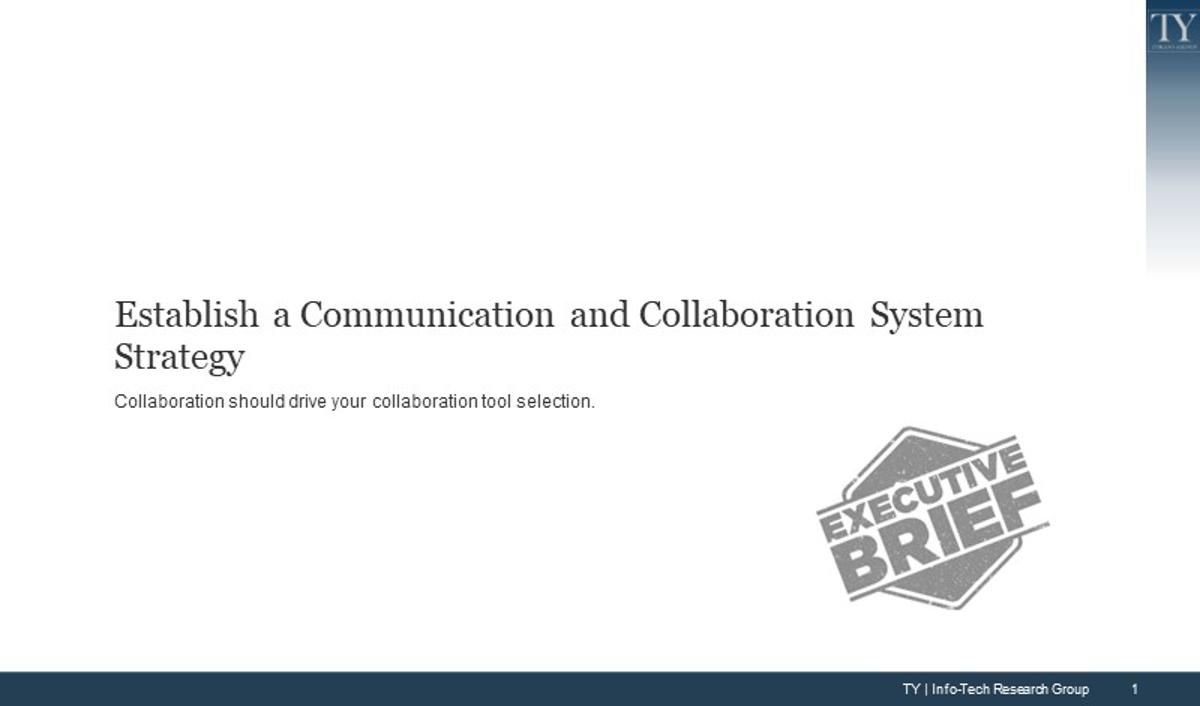Establish a Communication and Collaboration System Strategy

- Communication and collaboration portfolios are overburdened with redundant and overlapping services. Between Office 365, Slack, Jabber, and WebEx, IT is supporting a collection of redundant apps. This redundancy takes a toll on IT, and on the user.
- Shadow IT is easier than ever, and cheap sharing tools are viral. Users are literally carrying around computers in their pockets (in the form of smartphones). IT often has no visibility into how these devices – and the applications on them – are used for work.
Our Advice
Critical Insight
- You don’t know what you don’t know. Unstructured conversations with users will uncover insights.
- Security is meaningless without usability. If security controls make a tool unusable, then users will rush to adopt something that’s free and easy.
- Training users on a new tool once isn’t effective. Engage with users throughout the collaboration tool’s lifecycle.
Impact and Result
- Few supported apps and fewer unsupported apps. This will occur by ensuring that your collaboration tools will be useful to and used by users. Give users a say through surveys, focus groups, and job shadowing.
- Lower total cost of ownership and greater productivity. Having fewer apps in the workplace, and better utilizing the functionality of those apps, will mean that IT can be much more efficient at managing your ECS.
- Higher end-user satisfaction. Tools will be better suited to users’ needs, and users will feel heard by IT.
Establish a Communication and Collaboration System Strategy Research & Tools
Start here – read the Executive Brief
Read our concise Executive Brief to find out why you should develop a new approach to communication and collaboration apps, review Info-Tech’s methodology, and understand the four ways we can support you in completing this project.Besides the small introduction, subscribers and consulting clients within this management domain have access to:
- Establish a Communication and Collaboration System Strategy – Phases 1-3
1. Create a shared vision on the future of communication and collaboration
Identify and validate goals and collaboration tools that are used by your users, and the collaboration capabilities that must be supported by your desired ECS.
- Establish a Communication and Collaboration System Strategy – Phase 1: Create a Shared Vision on the Future of Communication and Collaboration
- Enterprise Collaboration Strategy Template
- Building Company Communication and Collaboration Technology Improvement Plan Executive Presentation
- Communications Infrastructure Stakeholder Focus Group Guide
- Enterprise Communication and Collaboration System Business Requirements Document
2. Map a path forward
Map a path forward by creating a collaboration capability map and documenting your ECS requirements.
- Establish a Communication and Collaboration System Strategy – Phase 2: Map a Path Forward
- Collaboration Capability Map
3. Build an IT and end-user engagement plan
Effectively engage everyone to ensure the adoption of your new ECS. Engagement is crucial to the overall success of your project.
- Establish a Communication and Collaboration System Strategy – Phase 3: Proselytize the Change
- Collaboration Business Analyst
- Building Company Exemplar Collaboration Marketing One-Pager Materials
- Communication and Collaboration Strategy Communication Plan
Workshop: Establish a Communication and Collaboration System Strategy
Workshops offer an easy way to accelerate your project. If you are unable to do the project yourself, and a Guided Implementation isn't enough, we offer low-cost delivery of our project workshops. We take you through every phase of your project and ensure that you have a roadmap in place to complete your project successfully.
1 Identify What Needs to Change
The Purpose
Create a vision for the future of your ECS.
Key Benefits Achieved
Validate and bolster your strategy by involving your end users.
Activities
1.1 Prioritize Components of Your ECS Strategy to Improve
1.2 Create a Plan to Gather Requirements From End Users
1.3 Brainstorm the Collaboration Services That Are Used by Your Users
1.4 Focus Group
Outputs
Defined vision and mission statements
Principles for your ECS
ECS goals
End-user engagement plan
Focus group results
ECS executive presentation
ECS strategy
2 Map Out the Change
The Purpose
Streamline your collaboration service portfolio.
Key Benefits Achieved
Documented the business requirements for your collaboration services.
Reduced the number of supported tools.
Increased the effectiveness of training and enhancements.
Activities
2.1 Create a Current-State Collaboration Capability Map
2.2 Build a Roadmap for Desired Changes
2.3 Create a Future-State Capability Map
2.4 Identify Business Requirements
2.5 Identify Use Requirements and User Processes
2.6 Document Non-Functional Requirements
2.7 Document Functional Requirements
2.8 Build a Risk Register
Outputs
Current-state collaboration capability map
ECS roadmap
Future-state collaboration capability map
ECS business requirements document
3 Proselytize the Change
The Purpose
Ensure the system is supported effectively by IT and adopted widely by end users.
Key Benefits Achieved
Unlock the potential of your ECS.
Stay on top of security and industry good practices.
Greater end-user awareness and adoption.
Activities
3.1 Develop an IT Training Plan
3.2 Develop a Communications Plan
3.3 Create Initial Marketing Material
Outputs
IT training plan
Communications plan
App marketing one-pagers
Buying Options
Establish a Communication and Collaboration System Strategy
Client rating
Cost Savings
Days Saved
IT Risk Management · IT Leadership & Strategy implementation · Operational Management · Service Delivery · Organizational Management · Process Improvements · ITIL, CORM, Agile · Cost Control · Business Process Analysis · Technology Development · Project Implementation · International Coordination · In & Outsourcing · Customer Care · Multilingual: Dutch, English, French, German, Japanese · Entrepreneur
Tymans Group is a brand by Gert Taeymans BV
Gert Taeymans bv
Europe: Koning Albertstraat 136, 2070 Burcht, Belgium — VAT No: BE0685.974.694 — phone: +32 (0) 468.142.754
USA: 4023 KENNETT PIKE, SUITE 751, GREENVILLE, DE 19807 — Phone: 1-917-473-8669
Copyright 2017-2022 Gert Taeymans BV